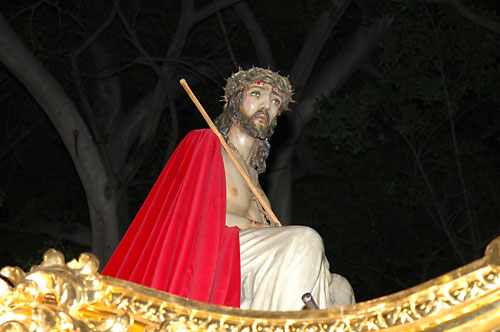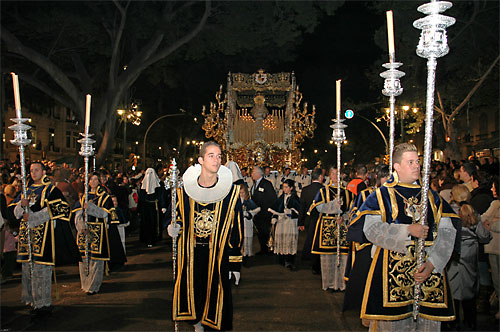History of Holy Week in Malaga
The celebration of Holy Week in Malaga took on its procession format with the Reconquest of the city by the Catholic Monarchs in 1487. The conversion of the inhabitants to Catholicism, together with the arrival of new inhabitants from Castile gave a new dimension, after centuries of Muslim influence, to the religious expression of the Malaga people. However, the Modern Age phenomenon that made the greatest mark on the future of the Brotherhoods was the Protestant Reform, the Council of Trent (16th century) and the later Catholic Counter-reform. The Catholic Church, in a clear endeavour to combat protestant doctrine, which they considered heresy, encouraged the new confessional current of worshipping sacred images.
Therefore, the Baroque period in Malaga was the time when new processional Brotherhoods were formed by the noble families of the city, linked both to new or existing fraternities. Naturally, the Holy Week in this period was totally different to that of today. All the processional “tronos” (hand carried platforms on which the images are mounted) left from their respective temples, as there were none of the “Brotherhood Houses” that appeared later on. The images were borne on rudimentary platforms, carried by 8 or 10 throne bearers, the cortege comprising the “Hermanos de Luz” (lit. brothers of light, i.e. those who carried the candles) and which would correspond to the “Nazarenes” that accompany the images in present day processions, and the “Hermanos de Sangre” (lit. brothers of blood), penitents who flagellated themselves during the whole procession, much to the fascinated horror of the public who gathered to watch this dismal display. Most of the brothers joined the Brotherhoods moved by the desire to obtain a holy place where their mortal remains could rest eternally, as well as an entity that would say the obligatory masses to pray for their errant soul as it searched purgatory for eternal celestial rest.
The 19th century with the Napoleonic invasions came continued sacking of the Brotherhoods’ heritage, with which a large part of what had been accumulated up to that time disappeared into the hands of foreigners.

On top of that, after the Spanish War of Independence, an event took place that was to affect the very foundations of the Brotherhoods. The Mendizabal’s Disentailment Act in 1835 eliminated a large number of convents including, naturally, many in Malaga. The disappearance of these convents forced the Brotherhoods to find new temples to house their images, from where they could initiate their processions during Holy Week.
In 1921 was created, of the "Malaga Holy Week Brotherhoods Association", the most veteran of its kind in Spain. From the first moment, the main function of this organisation was to obtain the necessary financial support to pay the expenses of the processions and in fact it was precisely in the 20s that Holy Week of Malaga began to become very popular attraction for the tourist of the times and, just as it does now, an unquestionable source of revenue for the city.
This golden age was unfortunately cut short due to political and social reasons. On the night of the 11th-12th May 1931, recently inaugurated the Second Republic, rioting groups of anarchists ransacked the temples of the city, destroying everything they contained. Following these events, the stormy social climate obliged the suspension of the procession, although in 1935 some Brotherhoods were able to take to the streets (since then called "the brave") risking the little heritage they had managed to get together. In 1936, the Spanish Civil War brought another wave of destruction, which more or less finished up with everything that had been saved from the previous outrage.
The post-war period was hard for everyone, including, of course, the processional Brotherhoods. The winners, with a clear “national-catholic” spirit, fostered the processions as a triumph over the enemies of the Catholic faith, magnifying and unashamedly politicising, during the first years, something that is so much “of the people” as the processions. As a result, the presence of military forces increased notably, although it had already been conspicuous in previous centuries. Another significant aspect would be the increase in the size of the tronos, on one hand due to the before mentioned desire to highlight the victory of the Catholic faith over the “atheist republican”, magnifying the tronos on which the sacred images were carried.
This in turn gave rise to other new elements in the procession and which are disappearing today, such as the “tinglaos”, metal structures that were built in the streets to house the trono and protect it (somewhat inefficiently) from bad weather.

This brings us to the present day, in which two forms of living and understanding Holy Week co-exist. Together with the school of thought developed in the post-war period (huge tronos, sumptuousness and luxury in the processional cortege), there is the other way of thinking, which began to appear at the end of the 70s with the new Brotherhoods (penitential spirit, greater austerity and putting greater weight on performing the penitential rite). In any case variety is something that defines the very essence of our Holy Week, a powerful reason to visit our city and enjoy this celebration that, for the people of Malaga, unquestionably marks the beginning of spring.
